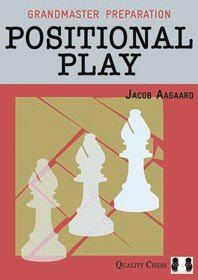Positional Play
Jacob Aagaard

The second book of Danish Grandmaster Jacob Aagaards 4 volume Grandmaster Preparation series, Positional Play, aims to improve positional understanding by asking three questions: Where are the weaknesses? What is the worst placed piece? What is your opponents idea? These might seem like simple questions but even very strong players, some of the very best in the world, can fail to ask them. A case in point is the following example from Aagaard’s book.
Modern Defense B07
Boris Gelfand- Alexander Morozevich
Moscow 2008
1.Nf3 g6 2.e4 d6 3.c4 Bg4 4.d4 Bxf3 5.Qxf3 Bg7 6.Qd1 c6 7.Nc3 Qb6 8.Be3 Qxb2 9.Na4 Qb4+ 10.Bd2 Qa3 11.Bc1 Qb4+ 12.Bd2 Qa3
White decided to repeat the position with 13.Bc1?,1/2-1/2, being unable to find any reasonable way to continue the game. Had he spent time thinking about activating his worst piece, the rook on h1, he might have come upon the solution:
13.h4!!
This move, originally suggested by Sergey Shipov, seems to be more or less winning by force.
13…d5
13…Bxd4 14.Ra3 Qxa4 15.Qxa4 Bxa1 16.Rb3 and Black cannot defend the queenside.
14.e5 e6 15.Rb1 Qe7 16.cxd5 exd5 17.Bd3
Whites initiative should be decisive. Black cannot easily get his bits out, and White is attacking on both flanks with a fully mobilized army. Obviously the game has a long way to go, and Black does have an extra pawn, but the chances are still entirely with White at this stage.
Positional Play offers the reader 222 well-chosen positions to solve, drawn primarily, but not exclusively, from recent practice. These positions are arranged around three themes: weaknesses, pieces and prophylaxis. Even those unable to solve the positions will derive benefit from the effort and the through solutions.
Accepted practice holds that all chess players should incorporate thirty minutes a day solving tactics. An extra half hour going through Positional Play would be time well spent.
Highly Recommended
